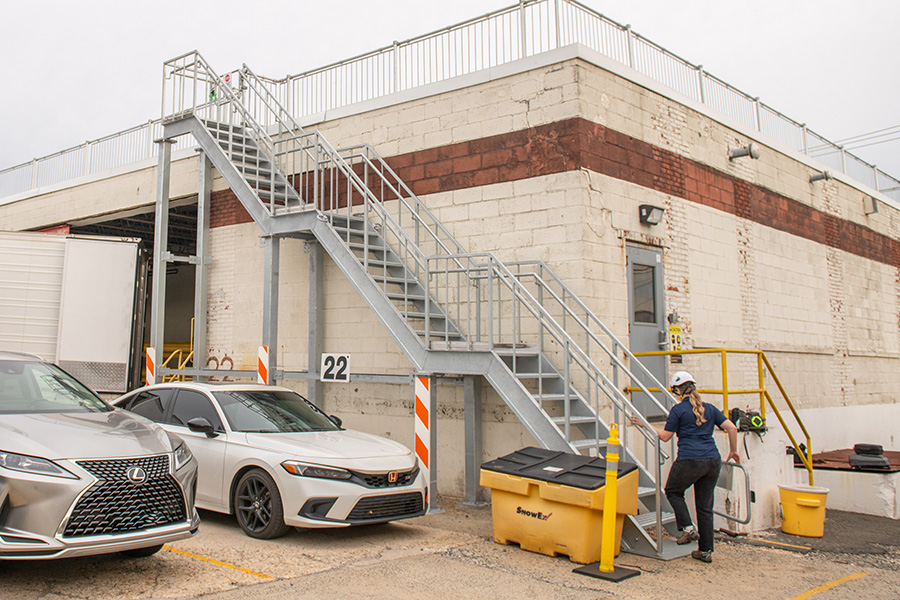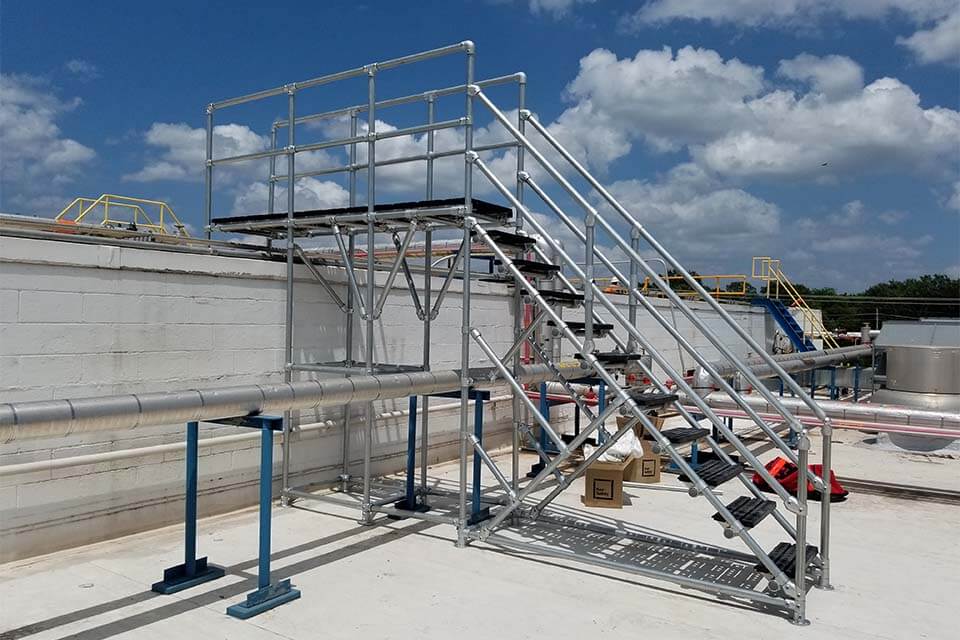Why Stairs are Safer than Fixed Ladders

I hate ladders.
As someone who frequently visits facilities for rooftop audits, I can safely say that ladders are more difficult to use than rooftop stairs. They make a day of inspecting facilities feel that much longer.
For instance, imagine you found your dream house. It’s the perfect size with every room that you want. It’s in the right neighborhood or situated on the perfect amount of acreage. Whatever you wanted, it has it...except one thing. No stairs. Instead, you have ladders.
Can you imagine climbing up and down those ladders just to get around your own home? This doesn’t even include the amount of work you’ll have to put in when you move in.
How many more injuries would occur in your home? How many items would fall and be broken? How much would you dread going upstairs day after day?
Now take that story and apply it to your team.
Your employees can spend most of their days outside, climbing several ladders to access the various roof levels. All of this to keep the HVAC running to cool the offices.
Having a ladder in your house sounds a bit silly, I know. But climbing a ladder 10 plus times in a day is a reality for maintenance workers and contractors.
As you plan how to update or add access to your facility, here are a few reasons why you should use stairs instead of fixed ladders.
It’s Easier to be OSHA Compliant with Access Stairs

Ladders were the number 3 cited OSHA violation in 2023.
There are many reasons for this, but here are a few extra requirements from OSHA for ladders that stairs don’t have.
Ladders should be inspected before the first use in a work shift. That’s a lot of inspections to complete. I don’t imagine everyone is doing this or even knows that OSHA says to do this in 1910.23 (b)(9).
Users are required to always have one hand grasping the ladder while climbing up and down it. This requirement makes it very difficult to carry clipboards while inspecting facilities. I do not like tucking these away in various pieces of clothing just to get to the roof. Or tucking it into a backpack, especially when there is a cage. Cages are not your friend when using a backpack.
A ladder safety system or personal fall protection system is required whenever a ladder is 24 feet or more in height. There is a lot that comes with using an active fall protection system. You will need training, PPE, regular inspections, and a rescue plan.
Also, can you imagine falling from a ladder only to swing and smash your face on a ladder rung?
To help with OSHA compliance, we wrote a lifeline guide to show what is needed when you use personal fall protection systems.
Self-closing gates or guardrail offsets are needed at the top of any ladder that is 4 feet or more in height. This protects users as they walk to the ladder while on the upper level.
All these guidelines are in place because OSHA is protecting the employee while using a ladder. In short, there is always the risk of injury on a ladder.
OSHA stair requirements, on the other hand, mainly focus on the design requirements and guardrail. Self-closing gates and lifelines systems are not required because there is no risk of falling off a staircase with guardrail around you. No extra training. No extra PPE.
Reduce Your Liability with Stairs

Climbing ladders is just plain awkward. And if you have to carry any equipment, forget it!
Besides, OSHA says that no employee can carry objects or loads that could cause the employee to lose balance and fall while climbing up or down the ladder.
Also, climbing multiple ladders in a day can be very tiring. This means that the ladders you climb later in the day are more likely to be the places where personal strength is compromised. A strong enough gust of wind comes at the wrong moment and a terrible accident can happen.
At least with stairs, you can sit and rest if it really comes down to it. Plus, the guardrail is a great handhold and protection from those types of accidents.
As if it’s not already awkward enough, OSHA requires you to add that fall arrest system to the middle of your 20” wide ladder. That’s not a lot of space to move your hands and feet when climbing a ladder. It’s also distracting to have a cable or track pushing against your body.
When a fall arrest system is introduced, your company opens the door to liability for both your employees and contractors. It’s not just “go climb that ladder” anymore. You must ask the following questions, every time someone goes up the ladder:
- Do you have the right harness with a sternal D-ring?
- Did you go through our internal training system to know how to properly use the fall arrest system?
- Have you reviewed the rescue plan we have in place?
There is major liability with fall arrest systems, which is why it is at the very bottom of the hierarchy of controls. If you choose to ignore those questions and someone were to fall, you will be facing a lot more hidden costs other than an OSHA fine.
Increase Your Efficiency with Stairs

As I said, I hate ladders.
They are cumbersome to climb. This is made more evident when you have gear that needs to be lugged to the upper level. If you measure efficiency in time alone, then you save time by not having to make multiple trips or using a slower davit arm to pull equipment to the upper level.
Stairs take less energy to climb than ladders, which means more energy can be used to get the work done.
It may not seem like a lot at first glance. However, consider doing this day after day, sometimes multiple times a day. How much could this save over time?
This doesn’t even consider your workers’ morale. Have you ever stood in front of a ladder and sighed? I have. When you don’t dread the work, it’s easier to complete it in a timely and more efficient manner.
Wrapping Up
I get that sometimes a ladder is required. Space requirements or budget can be a deciding factor.
However, where you have ample space, you should ultimately decide on stairs. The upfront cost might be more, but the long-term benefits far outweigh the risk that comes with ladders. You are considering the workers that do the work every day.
Contact an expert today to help mitigate liability and to help your team make it home at the end of the day.



